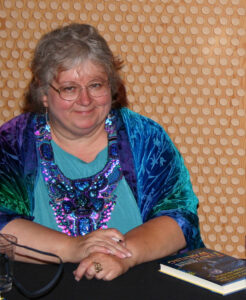Tag: Characters
E. Tip of the Week: Character Count
Characters are the life of every story so it’s important to treat them with respect and pay close attention to the details. However, it’s easy to get carried away and forget about some of the “don’ts” that come along with character building.
- If your reader needs to keep a notebook by their bedside every time a new character is introduced in your book, you’ve got too many characters.
- If you are having trouble keeping your characters straight in your own head, it’s time to limit the number of characters in the story.
- If your characters are screaming to have their own story, and not be a supporting role, it might be time to start an outline on a new story.
- If you have multiple characters whose names all start with the same letter like “s” or “m” consider changing two of the characters names to start with a different letter so the reader can keep the characters straight in their head. Or, decide if you really need those other characters.
- If you have a character just so the main character isn’t talking to themselves out loud, is that “friend” really necessary.
There are many more character “do’s” and “don’ts” but these are just a few I thought worth mentioning now. What are some of the “do’s” and “don’ts” you’ve learned over the years?
Written Dreams’ First Annual Writer’s Retreat: July 28th-30th, 2013
Written Dreams’ Writer’s Retreat
The first annual Written Dreams’ Writer’s Retreat will be held at the beautiful Miscauno Island Four Seasons Resort in Pembine, Wisconsin on July 28th through July 30th, 2013.
The fee for the Retreat is $159.00 per author. Reservations are required, and can be made by contacting us by email at admin@writtendreams.com. The deadline to register is June 25th, 2013. The Retreat fee includes all Seminars, admission to the Socials/Book Signing Event, Snacks during the Seminars, and the luncheon on Monday.
When registering, please give your name and contact information. We will also need you to make your luncheon selection. Choices are: California Chicken Sandwich, Hero Club Sandwich, or Blackened Salmon Caesar Salad.
We encourage attendees to stay at the hotel. Most rooms have kitchenettes and are wonderful accommodations. Room rates start at $119., and are not included in the Retreat fee. Room reservations for the hotel can be made by calling (877)-324-5244, or online at http://www.thefourseasonswi.com/. A buffet-style continental breakfast served daily is included with the cost of the room.
The itinerary for the conference is as follows:
Sunday, July 28th
Arrive at Four Seasons Resort and check in at the Written Dreams’ table set up in the Main Lobby. Check in for the hotel is any time after 3 P.M.
6:00 P.M.: Social Hour. Come meet your fellow attendees in a relaxed atmosphere.
Monday, July 29th
Continental Breakfast is served starting at 7 A.M. until 9 A.M. next to the Lobby by the Front Desk.
9 A.M.: Welcome and Who We Are
By Brittiany Koren & Lara Hunter
9:45 A.M.: Free Marketing, What It Is, and How To Get It
Presented by Barb VanDeHei
10:30 A.M. Break/Snacks
10:45 A.M.: How to Design A Website to Increase Your Visibility to Readers
Presented by Bill Koehne
11:30 A.M.: Social Media for the Not So Social Author
Presented by Lara Hunter & Bill Koehne
Noon: Luncheon will be provided in the conference room.
1:00 P.M.: The Joy of Independence: 7 Minutes to a Full-time Writing Business
Presented by Virginia McCullough
2:00 P.M.: How to Make Your Story and Characters Come Alive in the Minds of Readers
Presented by Brittiany Koren
2:45 P.M.: Concluding Remarks for the Day
By Lara Hunter
3:00 P.M. Free Time, Writing Time
The Written Dreams’ staff will be available for questions/discussion.
6:00 P.M.: Book Signing & Social Hour.
Please feel free to bring your books to sell and sign for other attendees/guests.
Tuesday, July 30th
Continental Breakfast is served starting at 7 A.M. until 9 A.M. next to the Lobby by the Front Desk.
9:00 A.M.: The Ins and Outs of E-book Publishing: What An Author Needs to Know
Presented by Lara Hunter & Kim Wickman
9:45 A.M.: Utilizing the Under-utilized Senses, and How to Get It Down on Paper
Presented by Barbara Raffin
10:45 am :Break/Snacks
11:00 A.M.: Missing Your Motivation to Write? Here’s How to Get It Back
Presented by Brittiany Koren
11:45-Noon: Concluding Remarks by Brittiany Koren & Lara Hunter
We’re looking forward to seeing you there! 🙂
- Photo Courtesy of Four Seasons Resort in Miscauno Island
Photo of the Week: It’s in the Details

When describing main characters, remember to include little quirks that make them stand apart from other characters in the story. This is important because it will help your readers “see” these characters, and therefore relate to them on a deeper level.
If you look closely you’ll see, for instance, the girl in this picture has a scar in her eyebrow. Her eyes are bright green and her hair almost white blonde while the hair in her eyebrow is darker.
These questions leap to mind. How did she get the scar? Does she color her hair, or is it natural?
And then from there, the story begins to develop. What is she looking at so intently? How old is she? What is it about this girl that makes her special?
Have fun with it, but don’t get too carried away. These little details, if not added in your first draft of the story, should be layered in during the second or third draft phase before the story is sent to an editor for review.
Good luck! 🙂
Writer’s Wednesday: Look Who’s Talking With Nebula-Award Winning Author Elizabeth Ann Scarborough
I’m so excited to have Elizabeth Ann Scarborough at The Editing Essentials! I’ve admired her tenacity and determination to be a successful author for a long time. She never gives up, no matter what the circumstances. Back in 2004, I was thrilled when she wrote a story for my anthology, You Bet Your Planet. Please help me welcome her today!
Elizabeth Ann Scarborough is the author of 38 fantasy/science fiction books, 24 solo novels including the Nebula-award winning HEALER’S WAR and 16 in collaboration with Anne McCaffrey, including the two most recent, CATALYST and CATACOMBS, Tales of the Barque Cats. Her most recent novel is THE TOUR BUS OF DOOM, set in a town suspiciously like Port Townsend. It’s her third story featuring the heroic Spam the cat, and is a spoof on the zombie craze. The first book SPAM VS THE VAMPIRE is the first of the “purranormal” mysteries. Bridging the novels is the novelette, FATHER CHRISTMAS. Please visit her website at: http://www.eascarborough.com/
Look Who’s Talking
The most important thing I need to know when I write a story is whose story it is. In fact, sometimes the viewpoint is the story when the plot is a familiar or classic one and the usual cast of characters is as time-worn as the Velveteen Rabbit’s fur. There aren’t all that many plots, after all, and none of them are actually new–or haven’t been for a very long time. But the stories we want to tell, and the ones readers gravitate towards, have certain universal elements that make them familiar.
If the central viewpoint is enlightening and informative of an entirely different facet of a story, it can actually make it new, suggesting an entirely different series of events than the original. Reinventing the villain from the Wizard of Oz, Gregory MaGuire created Wicked, the Life and Times of the Wicked Witch of the West (The Wicked Years). As Elphaba’s thoroughly grown-up tale, it becomes not only one different Oz-ish story but a series of them almost as extensive as the original Oz books. Elphaba isn’t thoroughly wicked, and those characters we’ve previously seen as thoroughly good, turn out simply to have had good press.
On a less complex level, other fairytales are often retold from a different character’s viewpoint to try to shake up a stereotype and allow readers to rediscover the tale from a new angle. Cinderella has been written, acted and sung from the viewpoint, at least partially, of the wicked stepsisters and their mother. In the past year, two different movies were made about Snow White, who may have been the protagonist, but the wicked queen, her stepmother, was the interesting, glamorous one. The reinvention of her character for Julia Roberts was brilliant and put a modern, accessible twist on the role that it never would have had if told only from Snow White’s viewpoint.
The “villain” usually doesn’t see himself or herself as a bad person, and neither should the writer when telling their versions of the story. It’s very possible the hero and the villain simply have different goals in life, or different interests in certain outcomes. We probably all know someone who has a lot of “bad luck” although there is never, according to them, anything they did to bring it upon themselves. They were either justified, victimized by circumstances, or someone was plotting against them.
Your characters don’t have to be totally good or wicked to see things in such dramatically different ways as to set them at odds with each other.
 I had a very nice mother, but her memory of certain events we both attended is so unlike mine that they might not have been the same occasions. If we were characters in one of my stories, I’d try to understand why she saw it her way as well as why I saw the same incident so differently.
I had a very nice mother, but her memory of certain events we both attended is so unlike mine that they might not have been the same occasions. If we were characters in one of my stories, I’d try to understand why she saw it her way as well as why I saw the same incident so differently.
That kind of conflict is certainly less dramatic than the fairytale kind and yet can be used to good effect if one bears in mind how annoying and baffling it can be to have people you thought you knew and even liked behave in ways you consider immoral or selfish, as in The Help, while they disapprove of you just as strongly.
I do admire an author who can capture the nuances of human nature accurately and use them to turn a plot at the same time. M.C. Beaton, aka Regency romance writer Marion Chesney, writes a series of contemporary mysteries that’s fun partially because it counters traditionally romantic stories while retaining a sense of reality.
The heroine, Agatha Raisin, a successful ad exec now a detective, is always falling madly for some good looking man, and at least two of them are interested in her only when she stops stalking them, and starts stalking murderers. There’s nothing remotely like a romantic novel romance in Agatha’s life, but there is friendship and admiration, unexpected emotional support when she least expects it and sometimes fleeting mutual lust. It isn’t done cynically but it seems very true.
The mysteries themselves aren’t nearly as involving as the characters. By now we all know that if the killer isn’t a psycho nut job it’s someone who stands to gain through love, or more probably money. But Agatha’s character makes it fun again, and ventilates scenarios that otherwise might be a bit stale.
Less specifically, but still of great practical benefit, understanding your characters and writing them as if they were real people with their own memories of events can be very helpful in submitting stories to theme anthologies. I edited four and published stories to about fifty more.
 For instance, in an anthology about Warrior Princesses, which I proposed during a time when Xena was very popular, each contributing writer had a distinct idea about what a warrior princess was. I was particularly floored by a two page submission from a friend who hasn’t written another story before or since, about a retirement home for aging warrior princesses, as told through correspondence between the facility and Her Fierce Highness’s anxious adult daughter. Absolutely ridiculous and yet well enough grounded in familiar concerns that I felt that if there were real warrior princesses, of course they would need a specialized retirement home.
For instance, in an anthology about Warrior Princesses, which I proposed during a time when Xena was very popular, each contributing writer had a distinct idea about what a warrior princess was. I was particularly floored by a two page submission from a friend who hasn’t written another story before or since, about a retirement home for aging warrior princesses, as told through correspondence between the facility and Her Fierce Highness’s anxious adult daughter. Absolutely ridiculous and yet well enough grounded in familiar concerns that I felt that if there were real warrior princesses, of course they would need a specialized retirement home.
In Anne McCaffrey’s touching story, The Ship Who Sang, Helva, the heroine, is challenged about whether or not she has been trained to have a sense of humor. “We are directed to develop a sense of proportion, sir, which contributes the same effect.”
As writers, it’s up to us to find our characters’ perspectives.
One other thing. While it’s necessary to have speeches properly attributed in dialogue, if you can tell who’s speaking by what each character is saying and how he or she is saying it, it is very successful dialogue.
Thank you, Elizabeth, for your sharing your tips and being with us today! 🙂 If you have questions for her, please feel free to post. Thank you!
Essay by Elizabeth Ann Scarborough, © 2012.
Take Action!
E. Tip of the Day: Take action!
It’s important to have a continuous flow of activity for your characters–whether they are renovating a house, cleaning their closet, or skydiving–readers want to read about what the characters are doing.
And action is the best way to do this. With their actions, show how the characters react to certain issues that in turn show who that character is by showing their emotional responses. I’m not saying have your character weep at the drop of a hat. I’m talking about action. Show the good deeds of the character, or their devious thoughts. Show how important it is to that character to have good will by donating their time around the holidays. Show your character actually at a food pantry, or homeless shelter interacting with people in their community. Show your characters doing things in every day situations readers can relate to. Do this, and your readers won’t be bored.
If you have questions on whether or not your plot needs a bit more action, feel free to contact us. We’ll help you improve your plot so your readers will be intrigued about your story. 🙂
Naming Characters
E. Tip of the Week:
A name is a great way to add more depth/backstory to a character’s background. Usually when an author uses a name of foreign origin, there’s a reason and a backstory that goes with it. For instance, using the name Nikita: perhaps Nikita’s family roots are Slavic and her mother wanted her to have a traditional Slavic name even though her family lives in the U.S. To learn more about her family roots and the meaning of her name, Nikita might explore the region where her ancestors once lived. This could be a journey she might not otherwise take, but because of her name’s origin, she’s curious.
Another way to add more depth to your character is by making their name an unusual spelling. My parents named me Brittiany, with an extra “i” in there. I have a few theories why my mother spelled my name differently–one of them being she just wanted my name to be special.
However, using a different spelling can sometimes lead to confusion with your readers. They may not know how to pronounce the name in their head, and could stumble upon it, taking them out of the story. So, be very cautious when using an unusual spelling. A lot of people pronounce my name Brit-ti-a-nee because of that extra ‘i’. It’s just Brit-nee.
I get questions like “Did you realize there’s an extra ‘i’ in your name?” all the time. “Yes,” I tell them. “I’m aware, and thank you for spelling my name correctly.” I’ve yet to meet someone with the exact spelling of my name.
But a unique name can be a great ice-breaker. I love the story I can share with people when I meet them for the first time, and they ask me about my name. 🙂
To find a unique character name, go to a baby names website, or get a few baby names books from the library. Find a name that has the meaning of what you’re trying to portray for the character. You might be surprised at what you find. Good luck!

![image[1]](https://writtendreams.com/wp-content/uploads/2013/03/image1-300x118.png)


